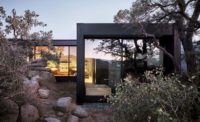Three poured-in-place concrete structures, each 100 square feet — and each with its own unique characteristics — are scattered within close proximity on a rocky, scrubby, 5-acre site in California’s Mojave Desert. These platforms are places upon which to sleep, read, or take in the sun’s rays, the night sky, and “the occasional lonely coyote howl,” says their owner, Jerry Sohn.
A codirector of Little Steidl, which publishes books created by artists, Sohn, his wife, Eba, and their young twins use these pavilons as much as time allows them to escape their Los Angeles home. It is a three-hour trek to their desert property.
An open slab 6 feet off the ground, which is designated for the summer months, requires climbing a stair.
A large rock acts as a natural headboard. A curved vault provides shelter from the wind and the morning dew for the spring/autumn pavilion, while a concrete cube, enclosed by glass, is reserved for the winter months.
It’s not the first time the idea of small shelters in nature has appealed to those who want to get away from it all. Henry David Thoreau’s cabin at Walden Pond (1845) and Le Corbusier’s Cabanon in Roquebrune-Cap-Martin (1952), in the South of France, famously preceded these structures. But these little objects in the Mojave Desert are very basic. “They’re really not supposed to be anything more than that,” explains Sohn. Except, perhaps, to Sohn’s friend, the Tokyo-based architect Arata Isozaki, who designed them.
Isozaki, who is known for his work on a grander scale — for example, the Museum of Contemporary Art in Los Angeles (1986) and the Kyoto Concert Hall (1995) — calls the collective piece “Obscured Horizon,” a term adopted from a text work by artist Lawrence Weiner. Appropriately, Weiner’s words are painted on the back surface of the spring/autumn platform.
Isozaki talks of the project as also being inspired by an important Japanese short text written in 1212 by Kamo no Chomei, titled “Hojoki.” The essay, often translated as “An Account of My Hut” or “The 10-Foot-Square Hut,” describes a small shelter that gives a bit of protection against the elements but mostly enhances the majesty of the surrounding landscape. Part sculpture — the work of Brancusi and Donald Judd come to mind, among others — and part architecture, the structures are “completely useful,” says Sohn.
Sohn has remodeled a 480-square-foot cabin on his property, but claims to have rarely slept inside. (Not surprisingly, the house is off the grid.) Even before the platforms existed, he preferred a sleeping bag outside. But his wife, who was not fond of the snakes that share the property, wanted something slightly elevated.
Sohn discussed the possibilities with Isozaki, and the architect, says Sohn, “was willing to create something exceptional. It was an opportunity for him to work on a very small scale, which he enjoys.” (Yuko Oka from Isozaki’s office helped with the project.) Isozaki offered the couple a “house” with three “bedrooms” — the desert as the floor, the sky as a ceiling, and no walls except for the unframed landscape.
Sohn made it a labor of love, convincing a contractor, engineers, and suppliers to travel the distance and accomplish the feat to the most exacting detail.
“They’re just fun,” says Sohn of the platforms. “You can use them, and you can look at them.” And you can think about them.





Post a comment to this article
Report Abusive Comment